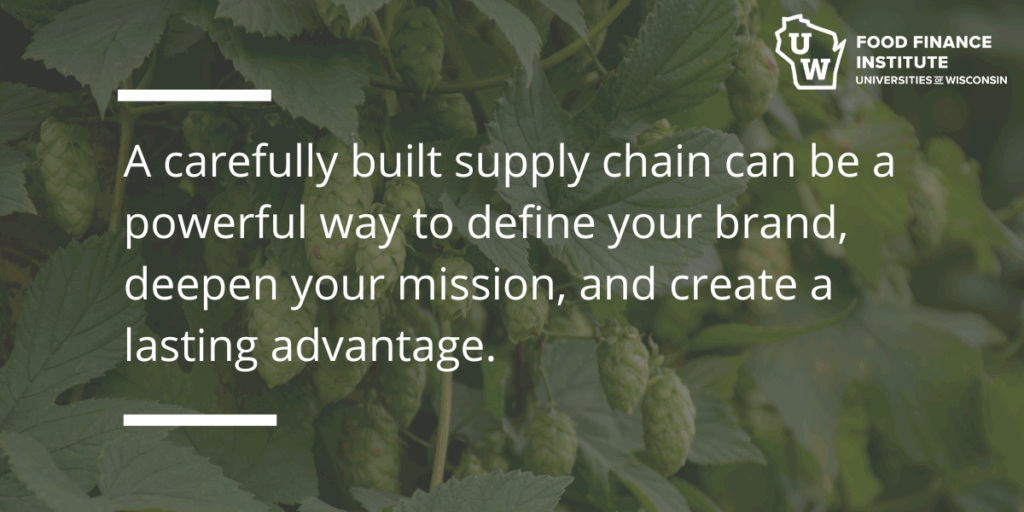Whether you’re in the early stages of growing your food business or already distributing regionally, you’ve probably felt the pressure of competing with bigger brands. One key question many entrepreneurs ask is: How can I stand out when my resources are limited?
One answer: your food supply chain.
While many people associate supply chains with logistics and procurement, a carefully built supply chain can be a powerful way to define your brand, deepen your mission, and create a lasting advantage, especially when navigating uncertainty in the food and beverage space.
What Makes a Food Supply Chain Unique?
There are many ways to make your food company defensibly unique. Maybe you’ve built a brand that speaks directly to people who feel left out of the category. Maybe you’ve developed a proprietary process that gives your product a special texture, nutritional profile, or flavor. But one piece that’s often overlooked is: where and how do you source your ingredients?
For example, maybe your product only tastes the way it does because of the type of chili grown on a family farm in southern Wisconsin. Or maybe your dairy comes from a cooperative using regenerative grazing methods that support soil health. Sourcing from these special places and building relationships to make those ingredients part of your product doesn’t just create something delicious. It creates a story your customers can believe in.
Can You Build Your Own Supply Chain?
Yes, but it takes time, capital, and intention.
If you’ve ever thought, “What if we could get this unique ingredient into our product every time, reliably?,” you’re already thinking like a supply chain innovator. And if that ingredient or process isn’t readily available, you might be looking at a chance to build something other brands can’t copy, at least not easily.
Let’s look at an example.
The company ReGrained makes bars and snacks using high-protein, high-fiber flour created from “spent” grain, a byproduct of the beer brewing process. But the supply chain for spent grain didn’t exist in the form they needed. So ReGrained built it.
They created partnerships with brewers, established consistent pickup and production systems, and turned what was once waste into a valuable, traceable ingredient. It wasn’t simple. It required navigating a lot of uncertainty around timing, quality, and volume. But now, ReGrained has a supply chain that’s part of their secret sauce. (You can hear co-founder Daniel Kurzrock talk about the early days of the business in this 2018 podcast interview.)
And while others could try to follow their path, it would take time to replicate. That’s the kind of competitive advantage that doesn’t just come from a marketing message; it’s baked into the business itself.
A Unique Supply Chain Sets You Apart
When you take the time to build or reconfigure your food supply chain, you’re doing more than solving a logistics problem, you’re building long-term value. You’re creating something that’s not easy for others to imitate. It gives your business a built-in advantage that sets your brand apart in a meaningful way.
But a unique supply chain doesn’t excuse you from validating your product with real customers. Market testing, even in small batches, is still key to knowing whether your concept resonates. You can use farmers markets, pop-ups, or local retailer partnerships to get early feedback.
As ReGrained learned, even a great idea needs education and trial to gain traction. Their bars entered a very crowded category, and part of their journey included helping customers understand what upcycled grain is and why it matters.
They’ve also expanded their impact by using their proprietary process as a co-packing service for other brands looking to upcycle grain. That kind of growth opportunity came after they figured out their supply chain and validated their product in the market.
Thinking Long-Term: Who’s at the Table?
Building a unique supply chain isn’t just about sourcing. It’s about relationships. You’ll need to align your suppliers, staff, co-packers, and funders around a shared vision. And that takes trust and communication.
You might need to negotiate long-term commitments, educate partners about your values, or coordinate logistics in new ways. You’ll likely face setbacks. But when it works, you’ll have more than just a unique product. You’ll have a business that’s truly built to last.
That kind of thinking – long-term, integrated, relationship-driven – is what helps food founders not only navigate uncertainty but also thrive in it. It involves asking questions practicing strategic foresight: the ability to sense, shape, and adapt to future scenarios.
If you’re asking yourself, How do I stand out from other brands? Take a look at your supply chain. It might just be the place where you can carve out your most meaningful competitive edge.
Want to learn more about how to finance, build, or scale your supply chain? The Food Finance Institute offers training, coaching, and resources to help you go from idea to infrastructure. Learn more about our on-demand workshops.
You don’t have to figure it all out alone. And your supply chain doesn’t have to look like anyone else’s.


